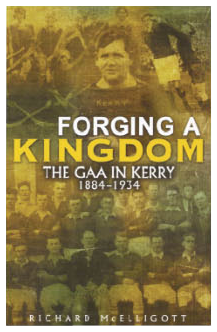Forging a Kingdom: the GAA in Kerry 1884–1934
Published in Featured-Book-Review, Issue 1 (January/February 2014), Reviews, Volume 22Richard McElligott (Collins Press, €17.99) ISBN 9781848891777 
By the time the GAA was two decades old, Kerry had won just a solitary All-Ireland title—and that was in hurling. It was later—owing in large part to the innovations of O’Sullivan, who would write The story of the GAA (1916), the first published history of the association—that the football tradition of the county was constructed.
Hence the title of Richard McElligott’s majestic study is most apt. This is the definitive account of how and why the GAA in Kerry rose from mediocrity to build a sporting dynasty that resonates deep in the Irish national psyche today. The narrative navigates skilfully through the political, social and economic landscapes that shaped the GAA in the local and national contexts over a 50-year period. No stone is left unturned in tracing the contours of this development, through the ups and downs of the Irish National League, the Irish Republican Brotherhood, agricultural productivity and the rural economy of Kerry, emigration, other sports, the Gaelic League, rail transport, the Irish Volunteers and the IRA, the wars of 1919–23, the internal structures of the GAA in the county and key administrative figures, as well as the role of Kerrymen in America and the evolution of the games themselves.
Throughout the book, McElligott demonstrates clearly how interwoven was (and is) the GAA into the fabric of society. For this reason, Forging the Kingdom constitutes an invaluable text on the history of a county and the dynamics of rural nationalist Ireland, let alone on the sporting aspect. The most enlightening chapter is probably that exploring the inglorious 1890s. In what is surely the most authoritative exposition to date of the effective collapse of the GAA in that decade, as well as the oft-cited Parnell split the author sets out a comprehensive survey of diverse other causes, including crop failures, poorly defined playing-rules, disputes between clubs, Catholic clerical opposition, the removal of the ban on members engaging in rugby, unpaid players’ travelling expenses and sheer apathy. Augmenting these arguments are tables and graphs, derived from census records, outlining the social profile of contemporary players.
Equally interesting are the chapters dealing with the more familiar turf of Kerry’s football fame from 1905 onwards. From this reappraisal we learn much about the significance of the county team’s introduction of training camps; the leadership of sporting revolutionaries like Austin Stack and Dick Fitzgerald; the role of the county’s replayed encounters with Kildare (in 1905) and Louth (in 1913) in the popularisation of Gaelic football; the part played by prominent ‘Kingdom’ football personalities in the republican movement in the 1920s; and how men from both sides of the Treaty divide played together to build the platform for the county’s golden era of four consecutive All-Ireland titles, 1929–32.
McElligott tackles head-on our received understanding of these events. The cultivation of a Kerry football tradition in this period, he acknowledges, owed much to the eulogising of an expanded press pack, akin to the fabrication of tradition surrounding the Munster rugby team in the 2000s—a comparison he can make without compunction, being a proud Listowel native. Forcibly brought home also is the harsh truth that while resources were concentrated on the county football team, the club football scene and the strong hurling pedigree of north Kerry and Kenmare were badly neglected. The legend of Kerry football as the embodiment of rugged rusticity, reinforced by common images of past players rowing to Valentia Island, running through rough fields or endorsing dairy products from a mountaintop, is countered by the disclosure that the urban centres of Tralee and Killarney dominated club affairs in the county for a long time. It is intriguing if not amusing to learn that on ‘Gaelic Sunday’, 4 August 1918, the day of the GAA’s celebrated national show of defiance, most of the programmed games in Kerry were rained off. McElligott further reveals that, pace depictions of post-Civil War harmony, political tensions persisted on the county team for the next decade, and the IRA still exerted a greater influence on the GAA in Kerry than anywhere else.
There remains a nagging question about the provenance of the fabled Kerry playing style: caid, we are told, was a local rough-and-tumble carrying game that survived up to the 1880s as a precursor to Gaelic football, so how come the notion of a distinctive Kerry football tradition of kicking and high catching was accepted so readily two decades later? Perhaps no clear answer to this puzzle exists. If there is a minuscule flaw in this book, it is not of the author’s making but rather one of debutant deference to the argument of other scholars that the GAA was a ‘fully fledged creation of the wider Victorian sports revolution’. Twice McElligott echoes this assertion, before proceeding to deconstruct it systematically; as he sets out, not the parish structure of clubs, nor their overlap with political units, nor the lack of class-based rules, nor the Sunday play, nor the low fees, nor the types of patron, nor sundry other aspects of the GAA mirrored the practices of other sporting organisations in Ireland or England. It was, in fact, more counter-Victorian than Victorian.
The author’s concluding remark that each county of the GAA warrants a similarly empirical monograph is well made. Forging the Kingdom furnishes as solid proof as could be found that sport, and the GAA in particular, has a profound significance far beyond the playing field. HI
Dónal McAnallen is the author of The cups that cheered: a history of the Sigerson, Fitzgibbon and Higher Education Gaelic Games (Collins Press, 2012).
















